|
CHURCHES
& PUBS GROUP
The group meets once a month – apart from January and August – when we
visit a Church, followed by lunch at a nearby Pub. Group members select the
churches and arrange the visits, often working in pairs. Where someone is new
to this, help and support is available from a more experienced member.
Number of Members - 30
Meeting Dates: The first Friday of every month, apart from January and August.
Contact Person – Lis Froggatt – l.froggatt66@outlook.com
St Nicholas Church, Fyfield – 7th November 2025
Seventeen
Group members visited the Church of St Nicholas in Fyfield on 7th
November. Our guide, Ian Bensted, told us that the first part of the Church to
be built was the nave, in around 1170. The Domesday Book recorded a church in
1086, so it was assumed that there had been an earlier, Saxon church at
Fyfield, though no trace of it survives. Later, in ca 1170, the chancel was
built by Sir John Golafre.
Our
guide took us on a tour of the Church and pointed out several interesting
features, including:
-
The tomb of Lady Katherine Gordon, a Scottish Princess who married Perkin Warbeck,
one of the pretenders to the throne of England. He claimed to be Richard of
York, one of the ‘Princes in the Tower’, and, following a failed challenge
against the King, he was executed for treason. Lady Katherine, ‘The White Rose
of Scotland’, became a favourite at the Royal Court and was gifted Fyfield
Manor by Henry VIII.
-
The monument to Sir John Golafre (the grandson of the first Sir John), who
built the 15th Century Packhorse Bridge over the River Thames at
Newbridge. The monument is of the type known as “memento mori” (reminder of
death), which has an effigy of a knight
in armour above, and a skeleton below.
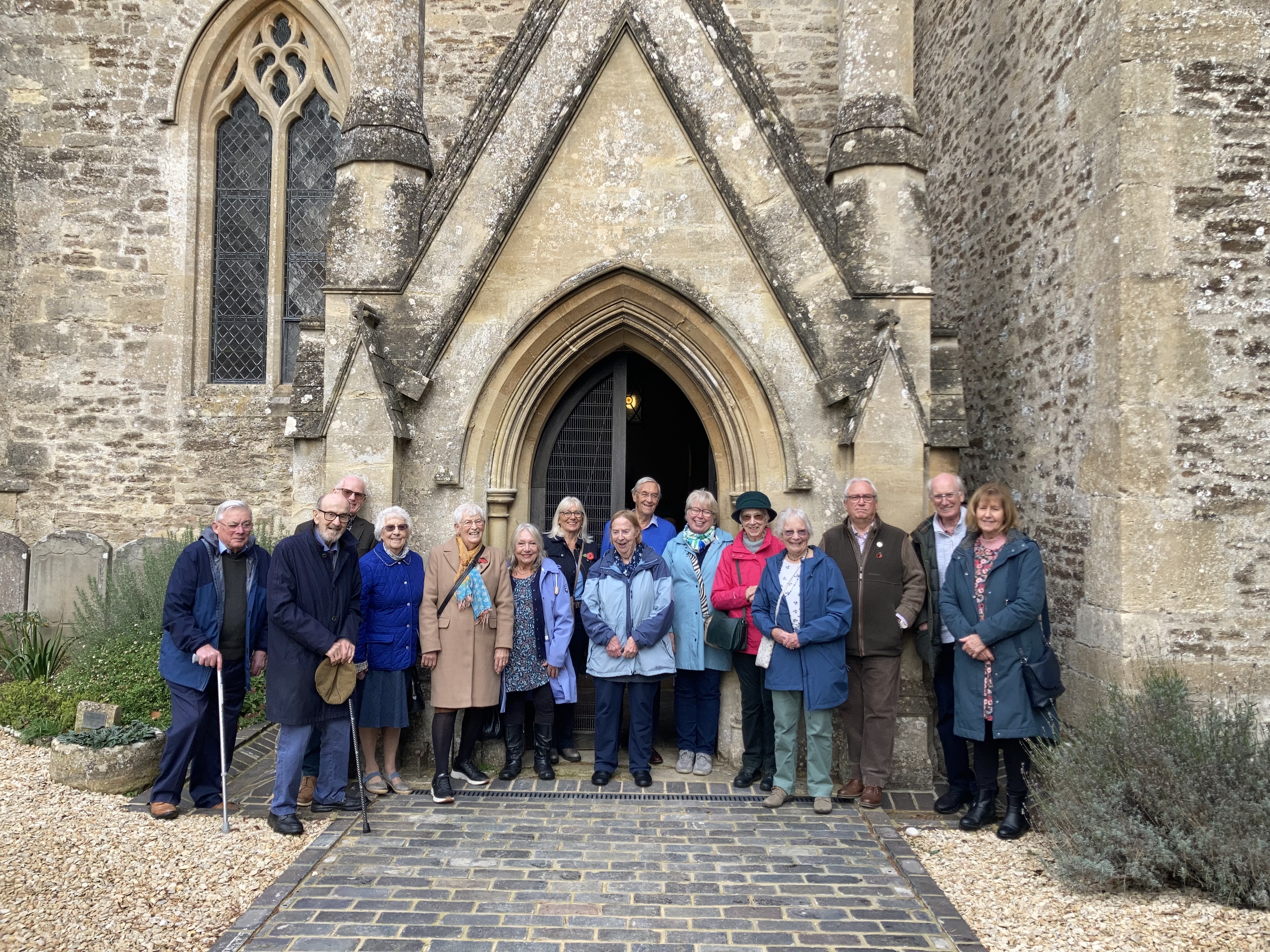
The Fyfield Church
visitors posing before the Victorian stone porch on the south wall (quite
different from the rest of the building).
We concluded a very interesting visit with lunch at The
Doghouse in Frilford.
This
was the final Church visit in 2025. The programme for 2026 has not yet been finalised.
The Church of St Denys, Northmoor – 3rd
October 2025
Seventeen
Group members visited the Church of St Denys, Northmoor. on 3rd
October. Our guide, Churchwarden Henry Herford, took us on an interesting tour
of the Church, which is very old: In 2010/11 the congregation held a Pageant to
celebrate 750 years since its inception.
We were
shown a number of features, including a stone altar put up around 1820, which
is surprisingly small for such a large church; a large oil-painting of Christ
carrying his cross, which is a copy of a painting in the chapel of Magdalen
College; some exquisite carvings of human heads on the corbels in the nave; and life-size stone
effigies of two members of the de la More family – Sir Thomas More depicted as
a knight in full armour, and his wife Isabella.
All
but a few fragments of the original stained glass windows have been destroyed. The
East Window now has a crucifixion scene created in the late Nineteenth Century.
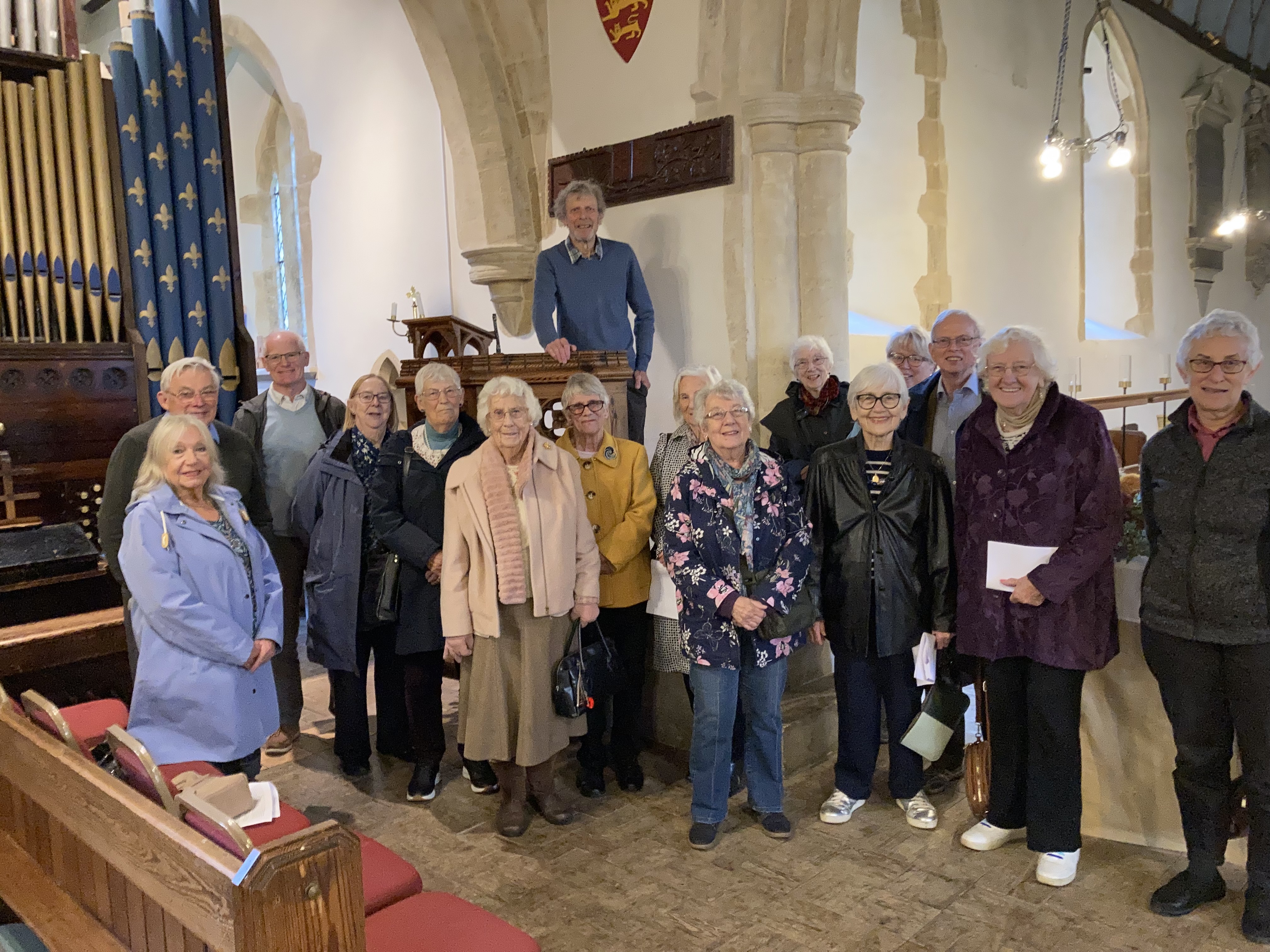
Visitors and Guide by the Pulpit of St Denys
We finished the visit with lunch at The Red Lion
in the village.
St
Mary’s Church, North Leigh - 5th
September, 2025
Sixteen
members visited the beautiful St Mary’s Church in North Leigh.
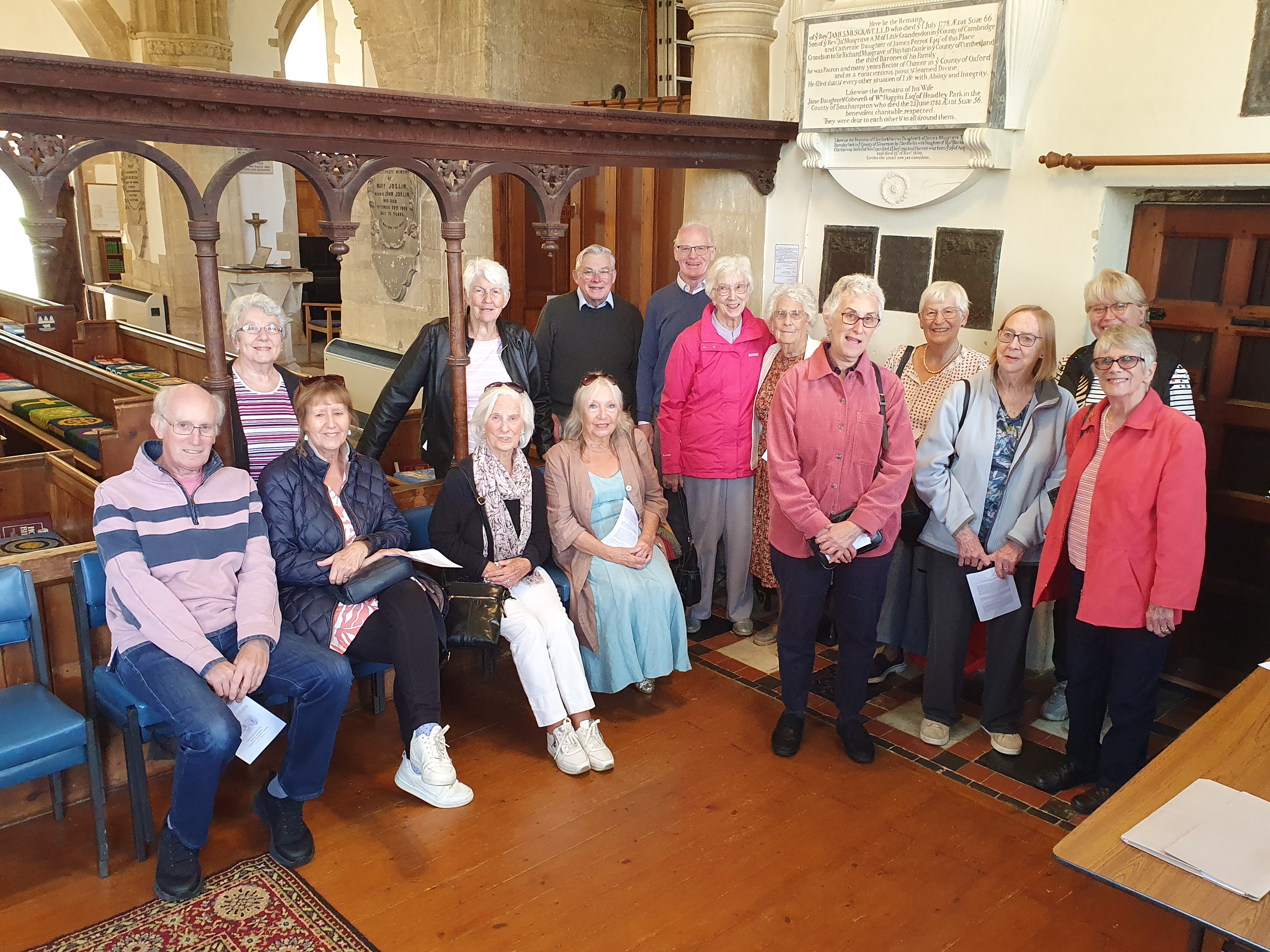
Rycote Chapel, Albury, Nr Thame – 4th
July 2025
The Group visit in July was to the beautiful
Rycote Chapel, which is part of Rycote Manor at Albury.
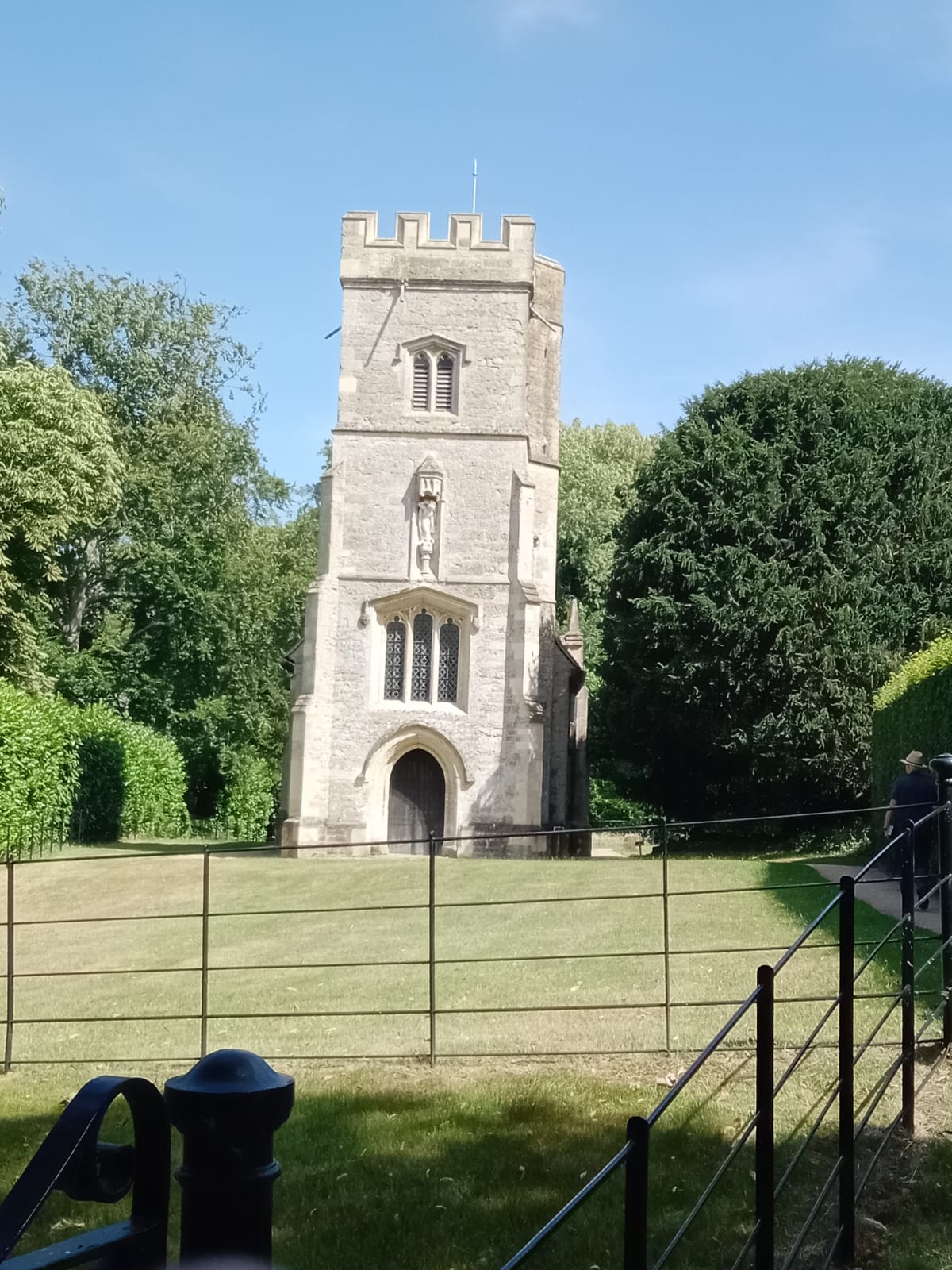
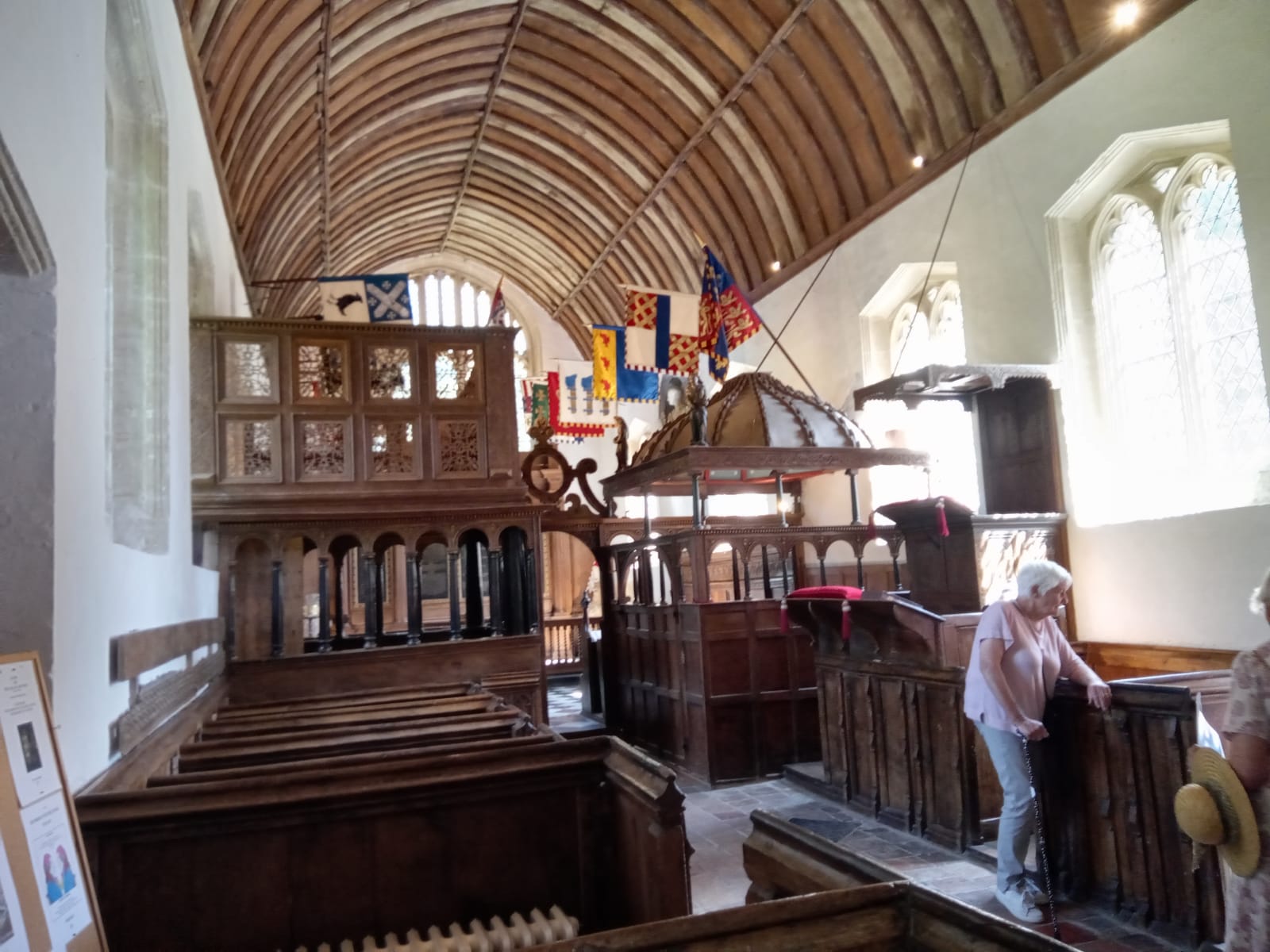 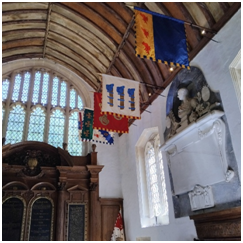
St Mary the Virgin, Charlbury – 6th
June 2025
Thirteen
Group members visited the Church of St Mary the Virgin on 6th June. This is a most
impressive church, parts of which date back to the 12th century.
Our
guide was Mike Summers, who gave us a talk about the history of the village and
the church, with particular emphasis on a major restoration project carried out
in the 1990s.
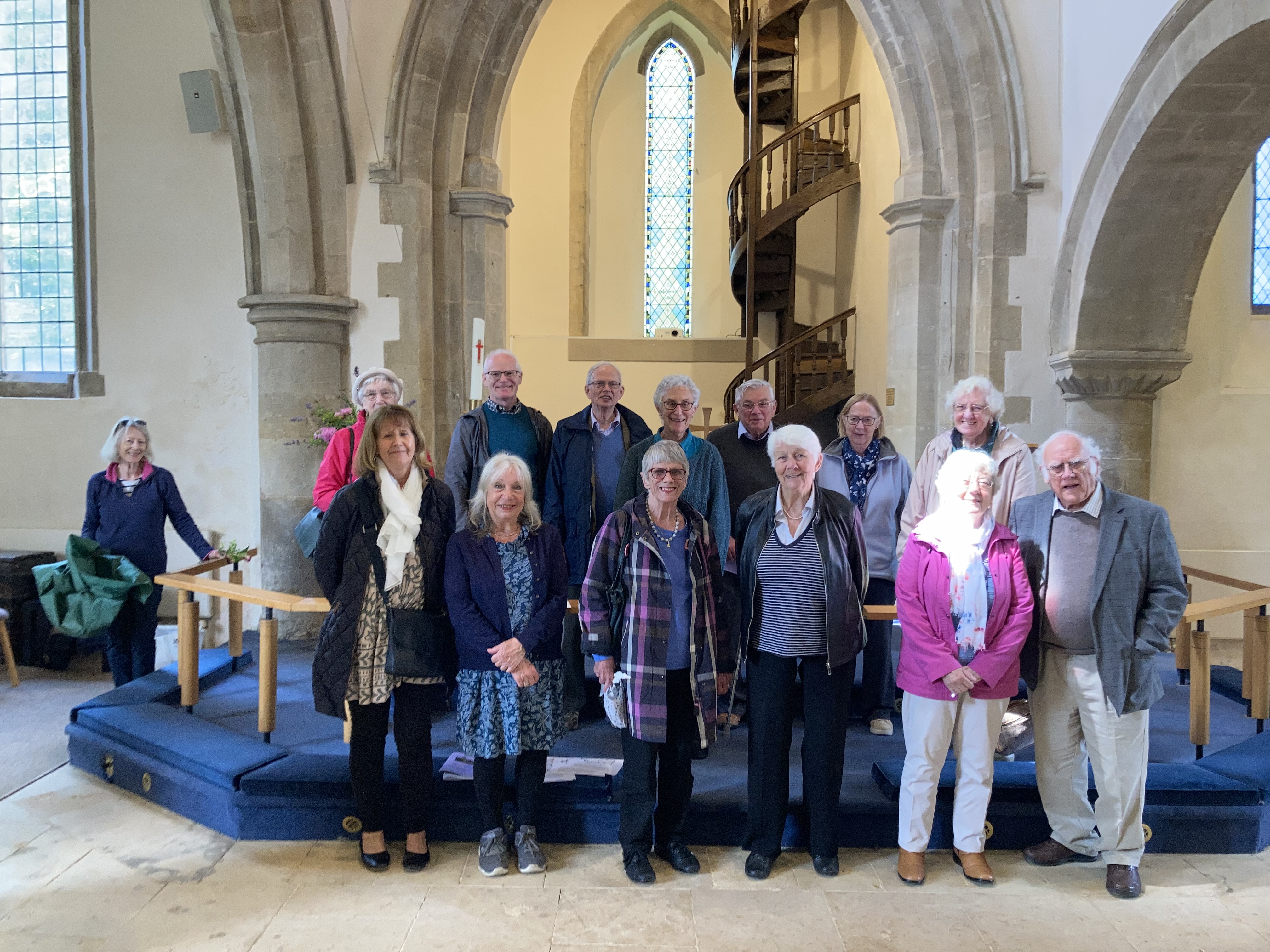
Visitors and guide in the beautiful Church of St
Mary. Also in the picture is local flower arranger Sarah.
Charlbury is a beautiful village, but the
restrictions on car parking are such that it took quite a major exercise to
transfer the visitors between the church and Woodleys, Woodstock where we had lunch at The Duke.
St Laurence Church, Appleton – 2nd May 2025
Sixteen Group members visited the Church of St
Laurence in Appleton on 2nd May. This is a lovely church, which was built and
developed over seven Centuries going back to the 12th. The oldest part is the
nave which dates to ca 1180. The fact that the Church has ten bells is a cause
of pride for the local community, and
the Appleton ringers are well-known for their enthusiasm and skills. The
original peal of six bells was donated, in the early 1800s, by a local
landowner, who also threw a party for the whole village; this is still
celebrated annually on 4th March. These facts, and more, were imparted by our
guide Roger Mitty, who gave us a fascinating talk about the history of the Church
and the Village. Roger was born in Appleton and his family’s connections with
the area go back many generations; his great-great Grandfather, Alfred White,
was a blacksmith who ran a business at The Greyhound at Besselsleigh. We also
learnt about the involvement of the
Blackwell family, who were and are still, benefactors of the Church. A
beautiful stain-glass window in the south wall depicting St Laurence, is
dedicated to Sir Basil (“The Gaffer”) and Lady Blackwell. The visit had been arranged by Branch Members,
Pauline and Jennie, who live in Appleton and are involved with the Church. We
were made to feel very welcome.

Some of the Visitors and Guide at lovely Appleton All Saints’ Church, Cuddesdon – 4th April 2025
The
Group visited All Saints’ Church at Cuddesdon on 4th April, which was a
beautiful day with blue skies and a gentle breeze. Our very knowledgeable guide, Robert Wilson, gave an
interesting talk about the church which was built, by Abingdon Abbey, around
1180 and was substantially extended and modified over the following seven
centuries. Robert said that All Saints’ was of a higher quality than most other
village churches, due to the fact that – from the early 17th century until the 1970s - the Bishops of
Oxford lived next door to the church, and worshipped there; the Bishop’s Chair
is situated in the chancel.
Our
guide told us the tragic story of Edward Pinson, a young curate who died in
1903, trying to rescue a drowning boy, Alan Martin. Both lost their lives and
we saw the grave in the churchyard where they are buried.

Visitors and guide posing for a group photo before
proceeding to The Bat & Ball for lunch

James in the Bishop’s Chair
The Church of St Mary the Virgin, Kidlington – 7th March 2025 Twenty
members of the Group visited the ancient and very impressive Church of St Mary
the Virgin in Kidlington. Mr Steve Handsley, our guide, gave a summary of the
history and style of the church. We were told that it is common, in cruciform
churches, for the chancel to lean (in this case to the south), which represents
the leaning head of Christ on the cross.
He
then took us on a tour of the church, pointing out particular features,
including: The stained glass window in the north wall depicting Faith, Hope and Charity, which was
copied from Sir Joshua Reynold’s famous window in New College Chapel, Oxford;
the east window which had been expertly renovated in the 1950’s, by removing
out-of-place Victorian glass and keeping only the original medieval pieces; and
some wood carvings in the Chancel which were rebuses of the name Kidlington,
picturing a Kid, a Ling (a plant) and a Tun (a large pitcher). 
After
a group photo in front of the Church, we finished the visit with lunch at The
Jolly Boatman at Thrupp.
The
next visit, on 4th April, will be to All Saints’ Church at Cuddesdon, followed
by lunch at The Bat & Ball in the Village.
The Church of St Mary the Virgin, Iffley – 7th February 2025
The
Group started its 2025 programme with a visit to the beautiful Church of St
Mary the Virgin in Iffley. This is a Romanesque church, built in ca 1160, which
is known for its marvellous stone carvings, particularly around the west and
south doors, which are full of symbolism. There are lovely stained glass
windows, including two by 20th Century artists, John Piper and Roger Wagner.
We
had four enthusiastic and knowledgeable guides - Elizabeth, Katharine, Marion
and David - who talked about the history of the church and pointed out
particular features. One of these is the area where Anchoress Annora lived for
nearly ten years enclosed in a cell attached to the church. Annora, a lady of high
birth, remained in the cell until her death and may have been buried there.

Visitors
and guides in St Mary’s Church, Iffley on a very cold day
We
finished off the visit with lunch at The Prince of Wales, nearby.
The
Church of St Mary the Virgin, Wheatley –
6th December 2024
Our
final outing before Christmas took place on 6th December, when nineteen members
visited the lovely Church of St Mary in Wheatley. This is a Gothic Revival
Church, built in the mid-19th Century by George Edmund Street. Group member
Brian Cox, who had organised the visit, gave a well-researched presentation
about the Church and its history.
John
Morrison, retired Archdeacon, and Church Warden Zanyfar Mason showed us some beautiful
vestments and explained the significance of their various colours – purple
(repentance – Advent, Lent); white (Christmas, Easter); red (the fire of
Pentecost); and green (the “default” colour).
They
also showed an Advent wreath with five candles, representing hope, peace and
joy (all purple), love (pink) and Christmas (white).

Beverley, Gill and Eileen admire the
“colour-coded” vestments

The Venerable John Morrison and Ms Mason explain
the Advent wreath to Nikki The
Church of St Mary Magdalene, Woodstock – 1st November 2024
Seventeen
members of the Group visited the Church of St Mary Magdalene in
Woodstock on 1st November. Our guide, Mr Howard Morris, gave an
interesting talk about the history and architecture of the Church, which was
first built by King Henry II in 1172, as a chapel of ease to use during his
hunting visits to Woodstock. The Church was substantially rebuilt in the 1400s
and during the Victorian era, but our guide referred us to some really old
features which still remain – a Norman door in the south wall, the surround of
which is nearly 850 years old; 23 stone heads around the south aisle pillars, one
of which is thought to be of King Henry; and the font, which was thrown out in
1400 and spent some 300 years as a birdbath in a local garden before being
reinstated.

Some of the visitors with our dapper guide 
Some of the old stone heads, including (perhaps) King Henry 
The beautiful old Norman door The Church of St Kenelm, Minster Lovell – 4th October 2024
Twenty-one
Group members visited the Church of St Kenelm in Minster Lovell on 4th
October. Graham Kew, who has lived in
Minster Lovell since the age of six, spoke to us about the Church, the Village,
and his own experience of residing there. We learnt about the Lovel Family, in
particular William, the seventh Baron Lovel, whose tomb is in the transept, and
his Grandson Francis who fought on the side of Richard III and, probably, came
to a sticky end.
The Church, which
dates from the 15th Century, has only one tiny stained glass window, the
rest probably having been destroyed
during times of trouble. 
The Church of St Mary the Virgin, Ewelme – 6th September
2024
There were twenty-two of us at the visit on 6th
September. The Group had been to St Mary in 2019, so this was a re-visit,
though there had been many membership changes in the intervening period. Ann
Sawyer who had spoken to us in 2019 did so again. She had much information to pass on to us,
and she did so in a very interesting and amusing way.
This 15th century church has a distinguished
history and many interesting features. It is well known for a magnificent
alabaster tomb and memorial to Alyce de la Pole, Geoffrey Chaucer's
granddaughter, who became Duchess of Suffolk. The Church is linked to a row of
medieval alms houses - very interesting.

Some of the visitors
in front of Princess Alyce’s tomb
We finished the visit
with lunch at The Shepherds Hut in the Village.
The Church of St Mary the Virgin, Broughton, North
Oxfordshire - 2nd August 2024
Twenty-one members visited St Mary the Virgin, at Broughton, North
Oxfordshire on 2nd August.
This magnificent Church is situated in the grounds of Broughton Castle,
not far from Bloxham. 
The Group agreed that the Church
visit was well worth the journey We had lunch at the Joiners Arms in Bloxham. The Church of St
Peter, Hook Norton - 5th July 2024 Twenty-two members visited the large and ancient Church of St
Peter in Hook Norton on 5th July. Professor Donald Ratcliffe of the
Hook Norton History Society gave us a fascinating talk about the history of the
village and the church. 
Some of the visitors and our guide We finished the visit with lunch at The Sun Inn, just opposite.
The Church of St Giles, Standlake – 7th June 2024
Twenty
members visited St Giles’s Church in the village of Standlake on Friday 7th
June. It was a visit with a difference,
as the main area of interest was the churchyard. The weather was clement.
Our two guides were Anne (PCC Secretary) and Lesley (retired history teacher), who had
much interesting information to share with us.

Some of the visitors
and our two guides, Anne and Lesley, in a flower meadow which will be the site
of the new churchyard.
We finished the visit with lunch at The Rose Revived, which is situated
in a beautiful spot by the river at Newbridge.
The Church of St Mary the Virgin, Freeland – 3rd
May 2024
Twenty-two
members visited St Mary the Virgin in the village of Freeland on 3rd
May. While most of our visits are to medieval churches, St Mary’s is a Gothic
Revival Church which was built in 1856, together with its rectory and village
school. It was designed by architect John Loughborough Pearson.
Brian
Cox, who was for many years responsible for the Group and has a strong interest
in Church architecture, talked to us about the 19th Century Gothic
Revival in England, mentioning in particular the amazing career of Augustus W N
Pugin, who managed to do so much before his early death at age 40.
Brian pointed to many features where St Mary’s,
being strongly influenced by French Medieval Gothic, differs from most English
parish churches: the vividly painted interior walls, the position of the square
tower at the west end, and the beautifully decorated sanctuary. It is quite
lovely. 
The beautiful Church
of St Mary

So much to see and
discuss
We finished the visit
with lunch at The Oxfordshire Yeoman. The Church of All Saints, Sutton Courtenay – 5th
April 2024
Seventeen
members had a most enjoyable and uplifting visit to the beautiful All Saints
Church in Sutton Courtenay. This started with coffee and home-baked cakes in
the River Room, a recent addition to the church premises, which boasts an
impressive stain-glass window.
We
then met the Rector, the Revd. Helen Kendric, who told us about the history of
the village and the Church; it was all very interesting and informative. We
learnt that All Saints had been extended and modified over the years but there
had also been some episodes of loss and destruction, particularly during the
Tudor Reformation and the English Civil War, when the Church was used for
storing gunpowder which exploded. The people buried in the graveyard include
former PM Herbert Asquith and George Orwell (buried under his own name, Eric
Arthur Blair).
Revd.
Kendric told us that she has held her post for over 20 years and she is proud
to be the 59th incumbent since 1091 – and the only woman!
The visit was rounded off with lunch at the
nearby Swan Inn.

Some of the visitors
with the inspirational Rector, Helen Kendric.
The Church of St Laurence, Warborough – 1st
December 2023
Twelve group members travelled to Warborough on a rather cold and
blustery day. On arrival we were met by our two guides, the Revd Myles Godfrey,
Stipendiary Priest and Michael Watkins, Church Warden, who invited us into the
Parish Hall – which was warmer than the Church. There we were served hot
drinks, chocolate biscuits and Christmas cake, while we learnt about the
history of St Laurence. The oldest parts of the Church date from ca 1200, though
it is thought that there may have been an earlier chapel there since 1140. In
1539 the living was acquired, and is still held, by Corpus Christi College,
Oxford.
We were then shown around the Church which has some wonderful
stained-glass windows. The visit was completed
by a “thought and prayer” moment, in the course of which we learnt about the
tragic story of Laurence, the patron saint.
We finished off the visit with lunch at The Six Bells.
We were made to feel
so welcome at Warborough and we all agreed that this had been a wonderful way
to conclude the year’s programme of visits.

The Church of St Laurence, Combe – 3rd
November 2023 Fifteen group members visited St Laurence’s
Church in Combe on 3rd November. This was at the time of Storm Ciarán, and the
weather had been grim, with lashings of rain and high winds. However, things
had improved and we had a beautiful morning for our visit. St Laurence dates
back to the 12th Century, when it was given by the Empress Matilda to the
Benedictine Monks of Eynsham. In the fourteen-hundreds it was granted to
Lincoln College, Oxford which remains the patron of the Living.
Our Guide was James, a student of Theology at
Oxford University, who lives in Combe and is very proud of the Church.
James told us about the history of St Laurence’s
and pointed out some interesting features, such as remnants of stained-glass
windows dating from the 15th Century, medieval wall paintings, a rare
stone pulpit, and some very old floor plates; one features a hare, an animal
traditionally associated with Combe.
We finished off the visit with lunch at The
White House in Bladon. 
Visitors and guide
enjoying the last of the morning sunshine. St Mary the Virgin, Chalgrove – 6 October 2023 Twelve group members made their way to
Chalgrove on a lovely early autumn day, to visit the beautiful Church of St Mary
the Virgin. The present building dates from the mid-12th century and is thought
to have been erected on the site previously occupied by a Saxon church. St Mary
has the most complete set of medieval wall paintings is Oxfordshire.
Our very knowledgeable Guide, Robert
Heath-Whyte told us about the history of the Church which was first gifted by
Edward II to one of his favourites, Piers Gaveston. Following the murder of the latter in 1312, the King
gave the Church to the Abbey of Thame.
Mr Heath-Whyte gave us a detailed description of
the wall paintings in the chancel, which depict the Tree of Jesse and the birth
and death of Jesus, as well as the death and Assumption of the virgin Mary. The
church has recently undergone a major renovation project, involving skilled
local craftsmen.

Visitors
in the
Chancel, marvelling at the splendid wall paintings. St Peter & St Paul, Wantage – 7 July 2023
Nine group members visited Wantage on a very hot summer’s day, starting
with lunch at The King Alfred’s Head pub, then walking the short distance to
the ancient Parish Church of St Peter & St Paul. It was beautifully cool.
Our Guide, Churchwarden Alastair Hunter, gave an interesting talk about
the history of the Church, the oldest parts of which date back to the 13th
Century. He pointed out a full length brass of Ivo Fitzwaryn, a member of an
important local family, whose parents are entombed in the Fitzwaryn Chantry,
and who himself became the father-in-law of Sir Richard (Dick) Whittington.
Most of the magnificent stained-glass throughout the Church dates from the
Victorian era but there is one small window containing medieval glass,
depicting St Stephen.
Alastair recited some
lines from the poem “On leaving Wantage”, by Poet Laureate John
Betjeman, a former long-term resident of the town. At the end of our visit we
were treated to a cup of tea and listened to the Church Bells play the hymn
tune “Angels’ Song” by Orlando Gibbons. The mechanism plays three verses
of this tune every three hours - day and night.

Visitors and guide on
the splendid tiled floor in the Chancel. St Andrew’s, Headington – 2 June 2023 Sixteen group members visited St Andrew’s in Headington on a beautiful
morning in early summer. The churchyard looked its best with the roses and
salvias in full bloom.
The Vicar, Fr Darren McFarland, gave an interesting talk about the
history of the Church and surrounding area. King Ethelred is thought to have
been christened there, and he is featured – wearing his crown – in the East
window which depicts the Adoration of the Magi. Fr Darren’s talk was full of
stories, some poignant, others very amusing.
We finished our visit
with lunch at The Black Boy, around the corner from the Church.

St Michael’s Church, Stanton Harcourt – 3 March 2023

Group members,
and guide, before the Shrine of
St Edburg.
Our extremely knowledgeable guide, Gillian Salway, provided a wealth of
information about the Village and the Church, and their connection with the Harcourt
Family; they have held the manor of Stanton Harcourt since 1191, and successive
generations are buried in St Michael’s.
There are numerous monuments, including one to Sir Philip Harcourt and
his first wife, Ann, who died at the age of 19.
We were given access to the Harcourt Chapel, which is not normally open
to the public. The tomb chests there include that of Robert Harcourt, a
prominent Yorkist, and his wife, Margaret, both wearing the Order of the
Garter. There is also an effigy of Sir Robert’s grandson, and namesake, who was
a standard-bearer, on the Lancastrian side, at the battle of Bosworth Field.
Amazingly, above him hangs a remnant of the standard itself.
It was a most interesting visit, which we rounded off with a delicious
lunch at the Harcourt Arms next-door.
St Bartholomew’s – 31 March 2023
 
Coffee in the magnificent Spencer Chapel
This was a very friendly and informal visit, led by the Vicar, Oliver
Petter, who has been in Yarnton for nearly five years. St Bartholomew’s is a
beautiful parish church, the oldest parts of which date from ca 1100. The
Spencer Chapel, which was built in the early 1600s, contains some extravagant
memorials, as well as an octagonal 12th Century font. Other special
features of the church include a number of sculptured alabaster reredos and some
wonderful stained-glass windows.
We were enchanted by the large collection of beautifully embroidered
kneelers.
Gill, whose father was a Master Carpenter 
We finished our visit with lunch at the smartly refurbished Turnpike.
St Michael’s and All Angels, Leafield – 5 May
2023

Some of the visitors and guide, Simon
Salome-Bentley
We had a nice day for our visit to Leafield, described as a small, modest
village with a very large church. This was built in 1859-60 to a design by Sir
George Gilbert Scott. The work was funded by the then Vicar, the “wealthy and
energetic” Rev. Henry Worsley. The
decorative sheet metal scrolls, which can be seen in the photograph, were
created by Mrs Worsley.
We finished our visit with lunch at the Fox Inn.
If you would like to join the Churches & Pubs Group please get in
touch with
Lis Froggatt, l.froggatt66@outlook.com
Back to Groups >>> 
|

